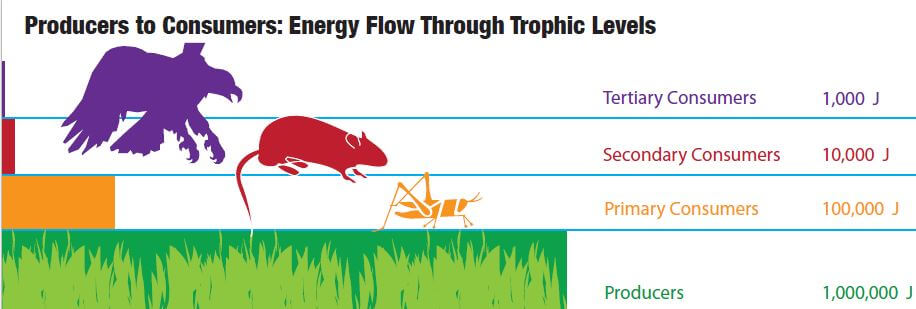Section 3

Section 3: Biological Processes Depend on Energy Flow Through the Earth System
3.1 The Sun is the major source of energy for organisms and the ecosystems of which they are a part. Producers such as plants, algae, and cyanobacteria use the energy from sunlight to make organic matter from carbon dioxide and water. This establishes the beginning of energy flow through almost all food webs.
3.2 Food is a bio-fuel used by organisms to acquire energy for internal living processes. Food is composed of molecules that serve as fuel and building material for all organisms as energy stored in the molecules is released and used. The breakdown of food molecules enables cells to store energy in new molecules that are used to carry out the many functions of the cell and thus the organism.
3.3 Energy available to do useful work decreases as it is transferred from organism to organism. The chemical elements that make up the molecules of living things are passed through food chains and are combined and recombined in different ways. At each level in a food chain, some energy is stored in newly made chemical structures, but most is dissipated into the environment. Continual input of energy, mostly from sunlight, keeps the process going.
3.4 Energy flows through food webs in one direction, from producers to consumers and decomposers. An organism that eats lower on a food chain is more energy efficient than one eating higher on a food chain. Eating producers is the lowest, and thus most energy-efficient, level at which an animal can eat.
3.5 Ecosystems are affected by changes in the availability of energy and matter. The amount and kind of energy and matter available constrains the distribution and abundance of organisms in an ecosystem and the ability of the ecosystem to recycle materials.
3.6 Humans are part of Earth’s ecosystems and influence energy flow through these systems. Humans are modifying the energy balance of Earth’s ecosystems at an increasing rate. Shifts occur, for example, as a result of changes in agricultural and food processing technology, consumer habits, and human population size.
 |
|
Imagine 25,000,000 joules (J) of energy falling on a population of plants. The plants will make use of about 1,000,000 J of this energy. As the plants are eaten by primary consumers, only about 10% of that energy will be passed on. This process of loss continues as primary consumers are eaten by secondary, and secondary by tertiary. Only about 10% of the energy available at one level will be passed on to the next.
|
 |
| Section 2 |
 |
| Section 4 |








